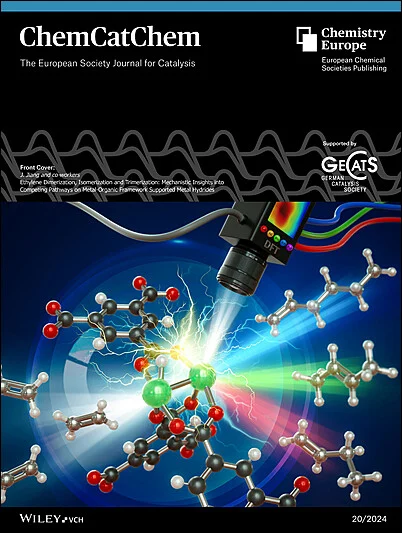制氢和氧化的比较电催化:锝与铼的三硫(硫醇)配合物
IF 3.8
3区 化学
Q2 CHEMISTRY, PHYSICAL
引用次数: 0
摘要
目前急需开发一种能够选择性激活和生成氢分子的高效催化剂。受能够催化产生和氧化 H2 的 5d 铼-三(硫醇酸盐)复合物的启发,我们通过 DFT 计算研究了 4d 锝-三(硫醇酸盐)类似物 [TcL3](L = 二苯基膦苯硫酚,一种非无毒配体)催化电催化 H2 氧化(HOR)和进化(HER)的机理,旨在阐明金属在金属-配体合作中的作用。DFT 计算结果表明,[TcL3] 在 HOR 和 HER 中的高反应活性超过了其 Re 配体。在金属-三(硫醇酸盐)配合物中,用 Re 金属代替 Tc 会导致 Tc 配合物中的巯基自由基比 Re 中的更大。即使两种复合物都以类似的[ECEC]机制演化出 H2,质子中继的表现也有明显的差异,Tc 复合物中的 S 配体与 Re 复合物中的金属-酸酐相比更具特色。根据预测,[TcL3]2+ 主要通过配体途径发生,因此 HOR 机制也会发生分叉,这与 Re 中主要的金属和配体反应形成鲜明对比。这项研究确定了金属在 HER 和 HOR 中的作用,同时强调了金属-DPPBT 在催化过程中的协同作用。本文章由计算机程序翻译,如有差异,请以英文原文为准。
Comparative Electrocatalysis of Hydrogen Production and Oxidation: Technetium vs Rhenium Tris(thiolate) Complexes
The development of an efficient catalyst that can selectively activate and generate hydrogen molecules is in urgent demand. Inspired by the 5d rhenium‐tris(thiolate) complex that is capable of catalytically producing and oxidizing H2, the mechanisms of electrocatalytic H2 oxidation (HOR) and evolution (HER) catalyzed by the 4d technetium‐tri(thiolate) analogs, [TcL3] (L = diphenylphosphinobenzenethiolate, a noninnocent ligand), were investigated by DFT calculations, aiming at elucidating the role of the metal in metal‐ligand cooperativity. DFT calculations anticipate high reactivity in both HOR and HER for [TcL3] beyond that of its Re counterparts. Substituting the Re metal for Tc in metal‐tris(thiolate) complexes results in a greater thiyl‐radical character in the Tc complex compared to that in Re. Even when both complexes evolve H2 with similar [ECEC] mechanisms, the proton relays behave with a distinct disparity, featuring the S ligand in the Tc species as compared to the metal‐hydride in Re. The HOR mechanism also bifurcates as [TcL3]2+ is predicted to mainly occur via the ligand‐based pathway, in contrast to the predominant metal and ligand‐based reactivity for Re. This study established the role of the metal in HER and HOR while emphasizing the utility of such metal‐DPPBT cooperativity in the catalytic process.
求助全文
通过发布文献求助,成功后即可免费获取论文全文。
去求助
来源期刊

ChemCatChem
化学-物理化学
CiteScore
8.10
自引率
4.40%
发文量
511
审稿时长
1.3 months
期刊介绍:
With an impact factor of 4.495 (2018), ChemCatChem is one of the premier journals in the field of catalysis. The journal provides primary research papers and critical secondary information on heterogeneous, homogeneous and bio- and nanocatalysis. The journal is well placed to strengthen cross-communication within between these communities. Its authors and readers come from academia, the chemical industry, and government laboratories across the world. It is published on behalf of Chemistry Europe, an association of 16 European chemical societies, and is supported by the German Catalysis Society.
 求助内容:
求助内容: 应助结果提醒方式:
应助结果提醒方式:


